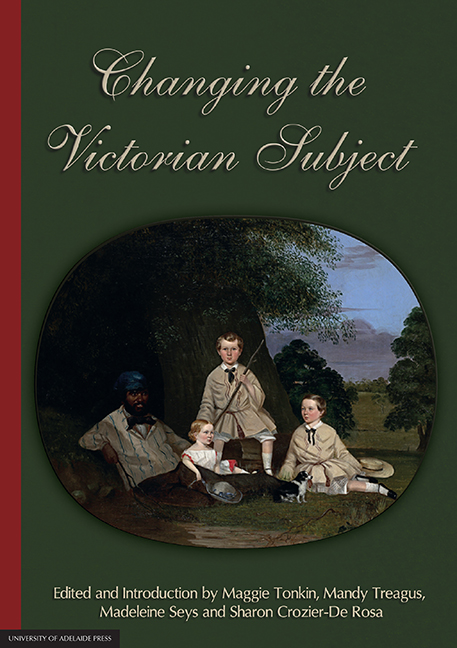Book contents
- Frontmatter
- Contents
- Notes on Contributors
- 1 Re-visiting the Victorian subject
- 2 Queen Victoria's Aboriginal subjects: a late colonial Australian case study
- 3 Identifying with the frontier: Federation New Woman, Nation and Empire
- 4 A ‘Tigress’ in the Paradise of Dissent: Kooroona critiques the foundational colonial story
- 5 The making of Barbara Baynton
- 6 A literary fortune
- 7 Olive Schreiner's From Man to Man and ‘the copy within’
- 8 Guy Boothby's ‘Bid for Fortune’: constructing an Anglo-Australian colonial identity for the fin-de-siècle London literary marketplace
- 9 The scenery and dresses of her dreams: reading and reflecting (on) the Victorian heroine in M.E. Braddon's The Doctor's Wife
- 10 The woman artist and narrative ends in late-Victorian writing
- 11 Miss Wade's torment: the perverse construction of same-sex desire in Little Dorrit
- 12 ‘All the world is blind’: unveiling same-sex desire in the poetry of Amy Levy
- 13 From ‘Peter Panic’ to proto-Modernism: the case of J.M. Barrie
5 - The making of Barbara Baynton
Published online by Cambridge University Press: 05 December 2014
- Frontmatter
- Contents
- Notes on Contributors
- 1 Re-visiting the Victorian subject
- 2 Queen Victoria's Aboriginal subjects: a late colonial Australian case study
- 3 Identifying with the frontier: Federation New Woman, Nation and Empire
- 4 A ‘Tigress’ in the Paradise of Dissent: Kooroona critiques the foundational colonial story
- 5 The making of Barbara Baynton
- 6 A literary fortune
- 7 Olive Schreiner's From Man to Man and ‘the copy within’
- 8 Guy Boothby's ‘Bid for Fortune’: constructing an Anglo-Australian colonial identity for the fin-de-siècle London literary marketplace
- 9 The scenery and dresses of her dreams: reading and reflecting (on) the Victorian heroine in M.E. Braddon's The Doctor's Wife
- 10 The woman artist and narrative ends in late-Victorian writing
- 11 Miss Wade's torment: the perverse construction of same-sex desire in Little Dorrit
- 12 ‘All the world is blind’: unveiling same-sex desire in the poetry of Amy Levy
- 13 From ‘Peter Panic’ to proto-Modernism: the case of J.M. Barrie
Summary
Barbara Baynton's oeuvre, though small, has always been a challenge. It has been viewed as somehow at odds with the work of her male contemporaries, while ostensibly covering much of the same ground in terms of setting and genre. Her work remains challenging, and this is not just in terms of her position in the national canon. Two characteristics of her writing serve to alienate the reader: her use of fractured narratives and her failure, deliberate or otherwise, to provide an authorial position with which to assist the reader's interpretation. Furthermore, as Hergenhan suggests, her writing — short stories and a novel — involves ‘a symbolic elusiveness, almost a concealment, possibly to evade censorship’ (211), probably to protect the discovery of truths that her protagonists themselves seek but fear to acknowledge.
There is a consensus amongst readers about one feature of Baynton's work. She is a dissident writer, but what does she dissent from? The notion that her writing fails to support the national ethos espoused by her male compatriots is not in doubt. Similarly, the view, first stated by feminist readers, that the target of her criticism is the sexism of a male-dominated society is not in dispute. Yet, these views do not account sufficiently for ‘the pervading vision of moral chaos and cruelty’ which her work delineates (Krimmer and Lawson xxiii).
- Type
- Chapter
- Information
- Changing the Victorian Subject , pp. 83 - 104Publisher: The University of Adelaide PressPrint publication year: 2014



